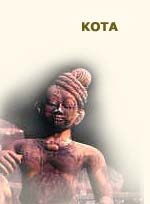 Along the eastern bank of the Chambal River lies Kota – an amazing juxtaposition of the majestic medieval age and modern industrialisation temples its untouched wealth of impressive forts, opulent palaces and splendid temples dating back over several centuries retain the past glory, the present day edifices and heavy industries have made it the industrial heartland of Rajasthan.
Along the eastern bank of the Chambal River lies Kota – an amazing juxtaposition of the majestic medieval age and modern industrialisation temples its untouched wealth of impressive forts, opulent palaces and splendid temples dating back over several centuries retain the past glory, the present day edifices and heavy industries have made it the industrial heartland of Rajasthan.
The history of the city dates back to the 12th century A.D. when the Hada Chieftain, Rao Deva, conquered the territory and founded Bundi and Hadoti. Later, in the early 17th century AD during the reign of the Mughal Emperor Jahangir, the ruler of Bundi -Rao Ratan Singh, gave the smaller principality of Kota to his son, Madho Singh. Since then Kota became a hallmark of the Rajput gallantry and culture.
The commanding fort stands overlooking the modern Chambal Valley Project with its many dams- Kota Barrage,Gandhi Sagar,Rana Pratap Sagar and Jawahar Sagar. An old palace,dating back to the time when Kota was under the control of Hada Chieftaincy-Hadoti faces the Kota Barrage. The Durbar Hall is ornate with beautiful mirror work and has ebony and ivory doors. Exquisite miniatures of the Kota school are housed within the Hall. Other noteworthy edifices of the bygone era are the Brij Raj Bhawan Palace,Jag Mandir-and island Palace, a splendid haveli (mandion) with beautiful frescoes and the royal cenotaphs.
PRIME SITES
 Chambal Garden: A beautifully landscaped garden at the Amar Niwas. Its lush surroundings make it a popular picnic spot offering enjoyable boar rides.
Chambal Garden: A beautifully landscaped garden at the Amar Niwas. Its lush surroundings make it a popular picnic spot offering enjoyable boar rides.
Maharao Madho Singh Museum: Situated in the old palace, the museum has a superb collelction of Rajput miniature paintings of the Kota school,exquisite sculptures,frescoes and armoury. The museum also houses a rich repository of artistic items used by the Kota rulers.
Museum: Housed in the Brijvilas Palace near the Kishore Sagar, the museum displays a rich collection of rare coins,manuscripts and a representative selection of Hadoti sculpture.Especially noteworthy is an exquisitely sculptured statue brought here from Baroli.
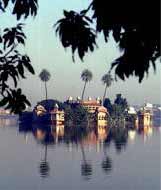 Jag Mandir: Amid the picturesque artificial lake of Kishore Sagar constructed in 1346 AD by Prince Dher Deh of Bundi, stands the enchanting little palace of Jag Mandir. The azure waters around the red-sandstone monument enhances its beauty.Boat-rides can be enjoyed in the lake. The Keshar Bagh famous for its royal cenotaphs lies in the vicinity.
Jag Mandir: Amid the picturesque artificial lake of Kishore Sagar constructed in 1346 AD by Prince Dher Deh of Bundi, stands the enchanting little palace of Jag Mandir. The azure waters around the red-sandstone monument enhances its beauty.Boat-rides can be enjoyed in the lake. The Keshar Bagh famous for its royal cenotaphs lies in the vicinity.
Haveli of Devtaji : The beautiful Haveli of Devta Shridharji is located in the middle of the busy market. The haveli is noted for its splendid frescoes and rooms ornate with lovely wall paintings.
Kota Barrage: A part of the irrigation canal system on the Chambal River,this beautiful setting is ideal for outings and evening strolls.
Other Places worth visiting: Kansua temple with a four faced Shiva Lingam, Bhitria Kund,Adhar Shila Budh Singh Bafna haveli and Yatayat Park.
EXCURSIONS
Bardoli (48 km): The oldest and the most beautiful temple complex of Rajasthan dating back to the 9th century A.D. lies on the way to the Pratap Sagar Dam. The intricate carvings and an exquisite image of Natraj (Shiva)-the cosmic dancer on the door of the mandap,offer fine examples of craftsmanship. Many interesting shrines also lie closeby.
Rana Pratap Sagar Dam and Bhainsrodgarh (50-55 km): Bhainsrodgarh Fort lies on the right bank of the Chambal River and a village lies within the fort. The fort is set amidst scenic surroundings. An ancient temple of Gaipar Nath Mahadev on the way is an idyllic picnic spot.
Bhanddeora Temple (Ramgarh) (110 km): Situated in the Baran district atop the Ramgarh hill, is the 11th-12th century temple now in ruins. Easily approachable by jeep and car.
The Remains of Garhgachh (110 km): The 9th and 13th century AD temples in red stone, situated in the Baran district near Atru (30 km).
Nahargarh Fort (145 km): An impressive structure in red stone, the fort is a fine example of the Mughal architecture.
Sitabari (120 km): An ideal picnic spot,situated near the village of Kelwara in the Baran district on the way to Kota-Shiv Puri. The old temples of Sita,Laxman and seven water tanks are worth a visit. The place is the venue of a tribal fair held in May/June every year.
Shergarh (125 km): A historic fort near Barora 10 km in Atru Tehsil in the Baran district.
Fort of Shahbad and Mosque (160 km): The fort was constructed in 1577 AD by the Chauhan ruler Muktaman. The mosque is the biggest in Rajasthan and was built during the reign of Aurangazeb.
Darrah Wildlife Sanctuary (50 km.): An erstwhile royal hunting preserve,it is a thickly wooded sanctuary lying along the south-eastern border of Kota adjacent to the mountain range. The wildlife variety includes panther, spotted deer, tiger, wild boar and bear.
Rock Paintings of Alaniya (25 km): Beautiful rock paintings adorn the bank of the River Alaniya.
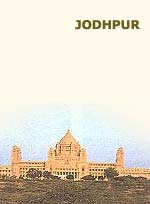 S
S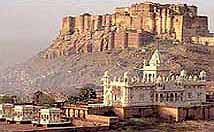 Mehrangarh Fort
Mehrangarh Fort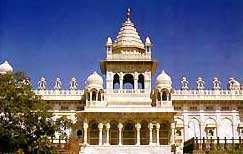 A cluster of royal cenotaphs in white marble built in 1899 A.D. in memory of Maharaja Jaswant Singh II. Within the main cenotaph are the portraits of various Jodhpur rulers.
A cluster of royal cenotaphs in white marble built in 1899 A.D. in memory of Maharaja Jaswant Singh II. Within the main cenotaph are the portraits of various Jodhpur rulers.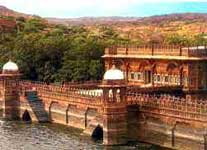 Mandore
Mandore Nagaur
Nagaur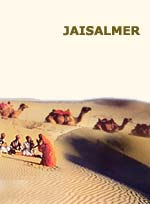 J
J
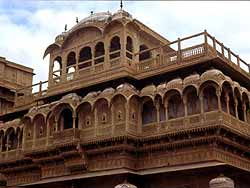 Manak Chowk and Havelis
Manak Chowk and Havelis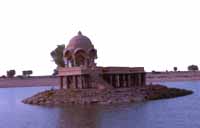 Gadsisar Lake
Gadsisar Lake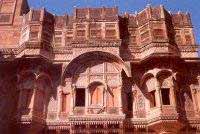 Patwon -ki-Haveli
Patwon -ki-Haveli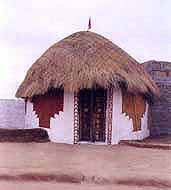 Sam Sand Dunes(42 km)
Sam Sand Dunes(42 km)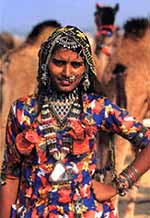 Desert National Park (45 km)
Desert National Park (45 km)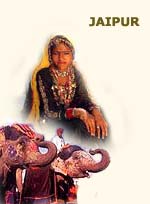 T
T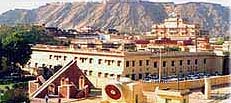 The City Palace
The City Palace 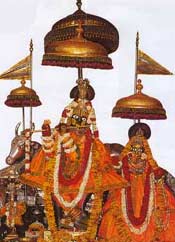 Govind Devji Temple
Govind Devji Temple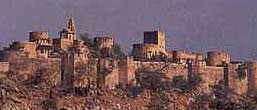 Moti Doongari
Moti Doongari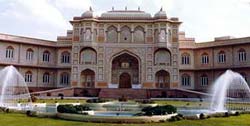 Amer Palace and Shila Mata Temple
Amer Palace and Shila Mata Temple 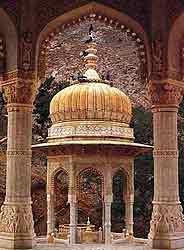
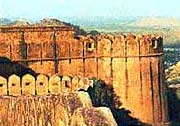 Jaigarh
Jaigarh Nahargarh
Nahargarh Ramgarh Lake
Ramgarh Lake 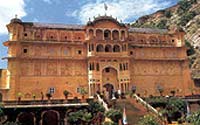 Samod
Samod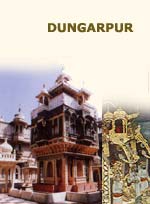 D
D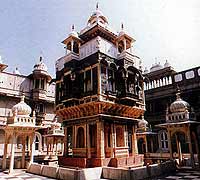
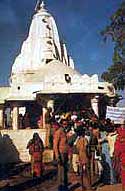
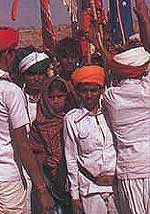
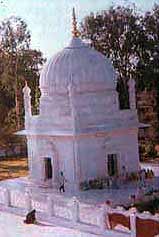 Galiyakot
Galiyakot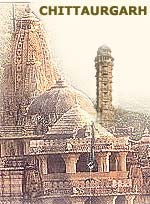 T
T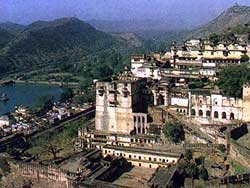
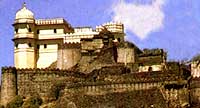
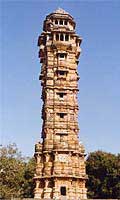
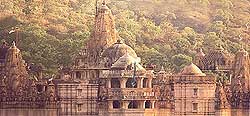 Gaumukh
Gaumukh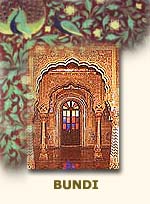 B
B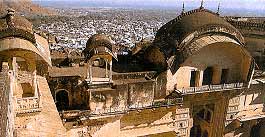 Taragarh fort
Taragarh fort Tara Garh Palace
Tara Garh Palace 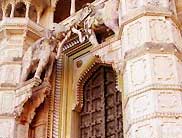
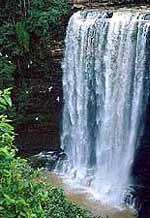 Menal
Menal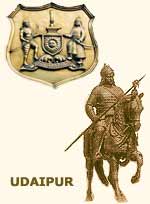 T
T
 Saheliyon-ki-Bari
Saheliyon-ki-Bari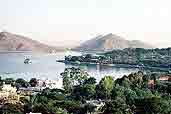

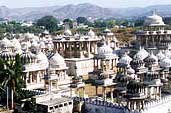 Ahar Museum
Ahar Museum
 Bagor Ki Haveli
Bagor Ki Haveli
 Nathdwara
Nathdwara


 Jaisamand Lake
Jaisamand Lake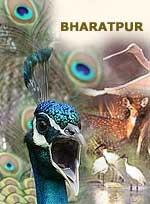 T
T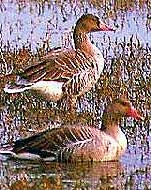 Birds of all shades and colors flapping their wings and diving into the water for fish, form the main scenario today in the old city of bharatpur. Migratory birds flock here in July- August but breed in October-November. They build their nests on the short trees which rise above the water level. There are literally thousands of birds, their beauty unbelievable but true.
Birds of all shades and colors flapping their wings and diving into the water for fish, form the main scenario today in the old city of bharatpur. Migratory birds flock here in July- August but breed in October-November. They build their nests on the short trees which rise above the water level. There are literally thousands of birds, their beauty unbelievable but true.



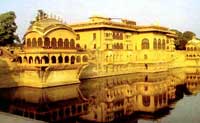
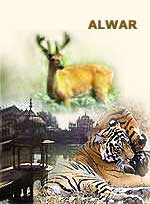 A
A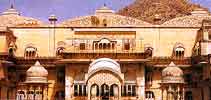

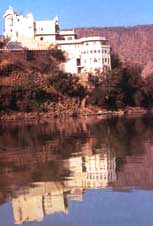
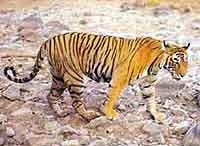 Located at a distance of 32 kms from Alwar, Sariska
Located at a distance of 32 kms from Alwar, Sariska Sanctuary was established in 1955 A.D. under the Rajputana Wild Animals and Birds Protection Act,1951. It is on the Delhi – Jaipur National Highway, 201 kms from Delhi. The area of the Sanctuary is about 461 sq. km. A large variety of indigenous birds and wild animals, particularly tiger, panther, sambhar, nilgai, wild boar can be seen in an evening drive round the Sanctuary. The valley has picturesque surrounding of wooden hills. Facilities are available for general shooting and tiger photography in the forests near Alwar .
Sanctuary was established in 1955 A.D. under the Rajputana Wild Animals and Birds Protection Act,1951. It is on the Delhi – Jaipur National Highway, 201 kms from Delhi. The area of the Sanctuary is about 461 sq. km. A large variety of indigenous birds and wild animals, particularly tiger, panther, sambhar, nilgai, wild boar can be seen in an evening drive round the Sanctuary. The valley has picturesque surrounding of wooden hills. Facilities are available for general shooting and tiger photography in the forests near Alwar .